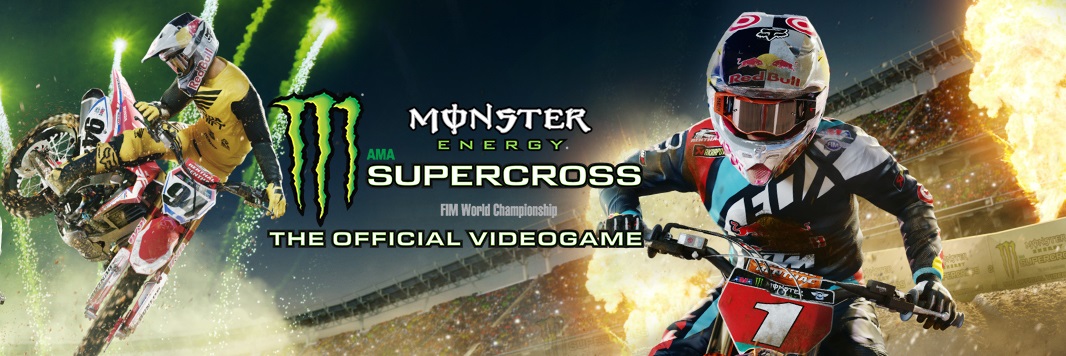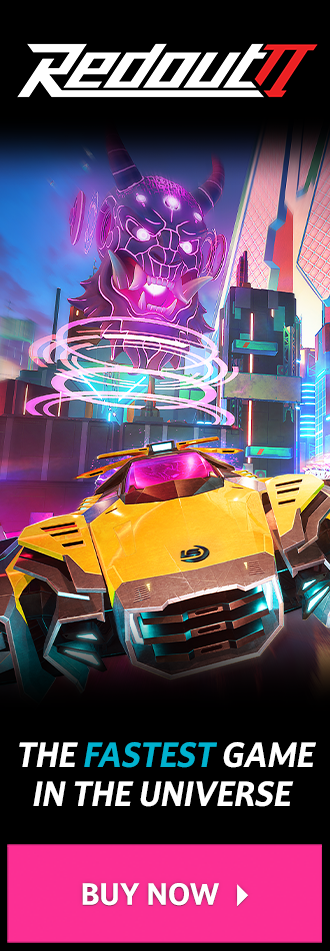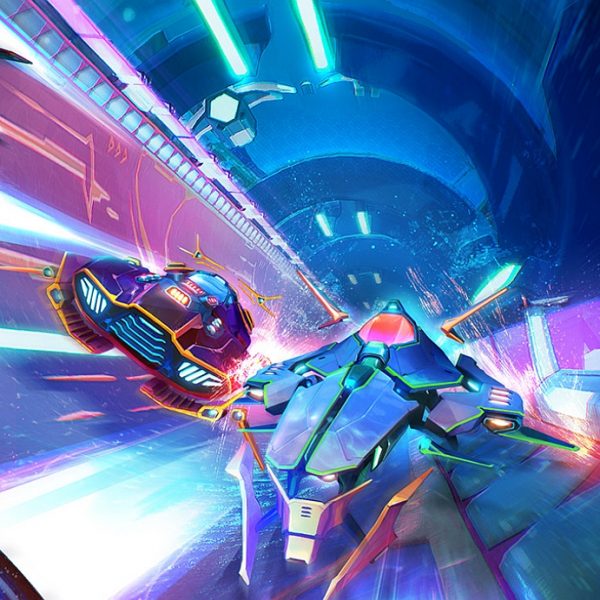Game: Monster Energy Supercross – The Official Videogame
Publisher: Milestone S.r.l
Release Date: 13/02/2018
Monster Energy Supercross – The Official Videogame continues Milestone’s monopoly of licensed bike games in addition to the annual MXGP and MotoGP series. Significant for being the first officially licensed Supercross game in many years, a sport that’s hugely popular in America, on the surface, you’d be forgiven for thinking Monser Energy Supercross is a rushed rehash of MXGP 3, the last dirt bike game developed by Milestone released last year. But you’d be wrong – this is more than just an MXGP 3 reskin.
In contrast to MXGP’s wide open dirt tracks, races in Monster Energy Supercross take place in narrow stadiums filled with spectacular jumps to test your skills. It’s a decidedly different, more technical style of racing than MXGP. Watching 22 riders pile into each other on the first corner and hurtle off their bikes on the first jump is thrilling in real life, and the game captures the sport’s intensity extremely well – you’ll soon learn that getting a clean start and avoiding the ensuing first-corner chaos is crucial.
Jumping with joy
Equally pivotal is how you approach each jump, as you need to adjust your speed, angle, and weight distribution accordingly using a combination of the triggers and two analogue sticks. Case a jump, and you’ll lose momentum and struggle to keep up with opponents. Approach or land the jump at the wrong angle, and you’ll almost certainly fall off your bike. Get it right, though, and learning when to feather the throttle and lean the bike to navigate a set of jumps and whoops without losing speed is extremely rewarding as you develop a rhythm. There’s a level of depth that past supercross games have often lacked.
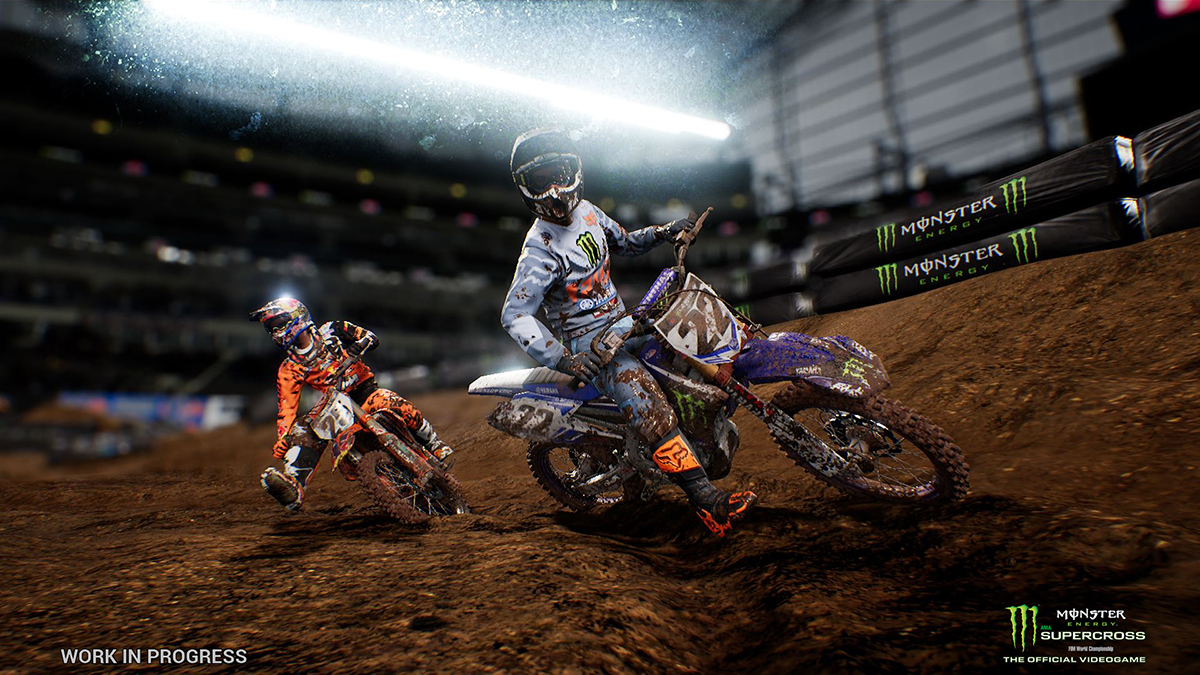
Unlike every other recent Milestone bike game, which offered three Standard, Semi-Pro and Pro difficulty levels, the physics in Monster Energy Supercross have been streamlined to two options. Assisted physics provide a more forgiving, arcade-style experience akin to the MX Vs ATV series, while the Standard option increases the realism and enables more precision. It helps clearly define the physics options for novice and experienced players alike – perhaps Milestone was inspired by Codemaster’s decision to divide DiRT 4 between “Gamer” and “Simulation” handling models.
AI difficulty can also be tailored to different skill levels and while the opponents behave realistically, often straying from the racing line and occasionally making mistakes, their slow pace means that veteran players will find it too easy to finish on the podium – even on the highest difficulty setting.
As with MXGP 3, tactical use of the rear brakes slides the bike around tight corners to block opponents, which is satisfying to pull off, while a well-timed scrub or whip over a jump can further reduce lap times. Bikes feel more responsive than MXGP 3, while scrubs and whips are more controllable in mid-air, reducing the risk of a failed landing. The physics still need some refinement, though. Minor contact with other riders rarely causes a crash, but seeing your bike land on another rider’s head before bouncing back onto the track without causing them to fall off ruins the immersion somewhat.

Bikes are split into two classes: 250SX and 450SX. 250SX bikes are nimble but underpowered, requiring a more technical approach to jumps, while the 450SX bikes are more powerful, allowing you to launch over jumps with more confidence.
There’s a steep learning curve to mastering the mechanics. Unfortunately, the game does a poor job of teaching the necessary techniques. Tutorials are hidden in the “extras” menu and are limited to brief two-line explanations with no demonstration videos to add context. Holding the clutch at the start of the race, for example, gives you a better start out of the gate, but you wouldn’t know this unless you explore the menus and find the specific tutorial.
Mandatory video or interactive tutorials at the start of the game would have been better. Instead, the game blindly drops you into a race with no guidance whatsoever. To be fair, assists are on, the AI is set to easy, and the event doesn’t affect career progress, but it’s still daunting for novice players. There’s no free-play practice mode available to help you hone your skills like MXGP 3’s Compound track either, so don’t expect Monster Energy Supercross to hold your hand at any point.
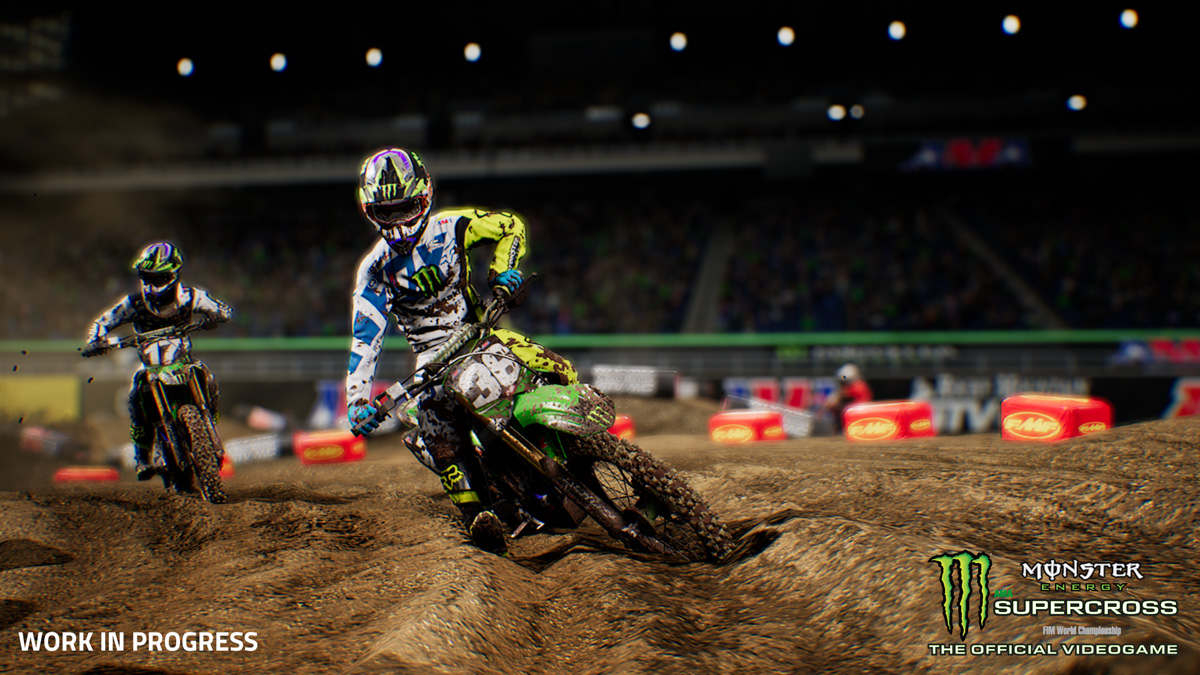
Mercifully, if you misjudge your speed and veer off course (which you frequently will), the infuriating instant respawns in MXGP 3 have been replaced with a three second respawn timer. It’s a far better system that gives you more time to recover, rather than instantly forcing you to start at your last position from a standstill like before. Rewinds also return, should you need to correct any mistakes.
Fans of the real-life Monster Energy Supercross championship will be pleased with the game’s authentic presentation, which perfectly captures the atmosphere of supercross. In contrast to MXGP 3’s European locations, each of the game’s 17 stadiums are set in North America and parts of Canada, and this affects the game’s tone. Gone is MXGP 3’s headache-inducing techno music, replaced with a generic rock soundtrack that at least suits the aggressive racing style, while pyrotechnics a create a spectacle at the finish line, bringing back fond memories of DiRT 2.
Milestone’s latest dirt bike racer does an excellent job immersing you into the world of supercross. All 22 riders from the official championship feature with recognisable likenesses thanks to 3D-scanned face models, though the gormless character models look a tad creepy close-up in cut scenes – Milestone should stick to modelling bikes instead of humans. Spectators cheer loudly whenever you execute a crowd-pleasing scrub, and the sound of stadium announcers add to the immersion. Replays look stunningly realistic, too, thanks to authentic TV-style camera angles including GoPro and shaky helmet cameras depicting a scary sense of speed. Supercross commentator Ralph Sheheen even provides voiceovers at the start and end of each race, but some of his stilted line deliveries leave a lot to be desired.
It’s a shame that Milestone hasn’t incorporated any live action footage of the Supercross championship, as this would have made the menu presentation less lifeless. Likewise, Real Events, a mode that used to be a staple of Milestone games where you re-enacted memorable moments from motorsport championships, is also sorely missing, which is a shame as it offered great fan service in other Milestone games. You get the feeling that the developer isn’t using the Monster Energy Supercross license to its full potential, despite the branding appearing at every opportunity.
On consoles, Monster Energy Supercross lacks some of the PC version’s polish, with reduced particle effects and texture resolution, but it’s still a graphically gorgeous game with impressive bike and rider models and highly detailed environments, which is particularly impressive since the game stadium and crowd has to be rendered all the time. Running on Unreal Engine 4, a TV-style filter gives the visuals a grittier, more realistic look, resulting in sharper visuals than MXGP 3’s softer image. Subtle effects, such as specs of dirt sticking to the camera that become visible under the blinding floodlights, puddles shining in the light, and rider overalls rustling in the wind further enhance the realism. This is easily Milestone’s most authentic-looking game yet, and an impressive improvement over MXGP 3 considering it was released only one year ago.

If you’ve played a Milestone-developed racing game recently, there’s nothing new in the career mode whatsoever. Once again, you create a custom rider, participate in championships, attract sponsors, and advance through different bike classes to become the Supercross champion. A fake social media feed highlights fan reactions to your performance, but, aside from the satisfaction of progressing to the higher 450SX class, there’s little here to keep you invested.
After playing the more personalised careers in Sebastien Loeb Rally Evo and Valentino Rossi: The Game that gave you an insight into the drivers and riders and MotoGP 17’s Managerial mode, Monster Energy Supercross’s career feels uninspired. Those who want the most authentic experience possible can participate in full race weekends with an initial qualifier, heat, and the Last Chance Qualifier before the main race, which can last up to 20 minutes. More casual players can skip all of this and dive into quick five-minute races, however.
Pimp my rider
Perform well by winning races and executing tricks and you’ll unlock Prestige points, which contribute to your overall ranking and unlock unique customisation options, as well as credits to spend on personalising your bike and rider. Customisation has been a staple of every bike game developed by Milestone since Ride, but Monster Energy Supercross takes it to the next level.
Awkward developer mug shots representing your rider avatar are now thankfully a thing of the past, as you can now choose between ten rider face types. Rider height can also be adjusted, but there are no female avatars available, sadly. While you can’t adjust the facial features, a plethora of outfit and gear customisation options are available. Everything from your helmet, goggles and gloves, to the rider’s butt patch can be changed, with a huge selection of options available from licensed brands.
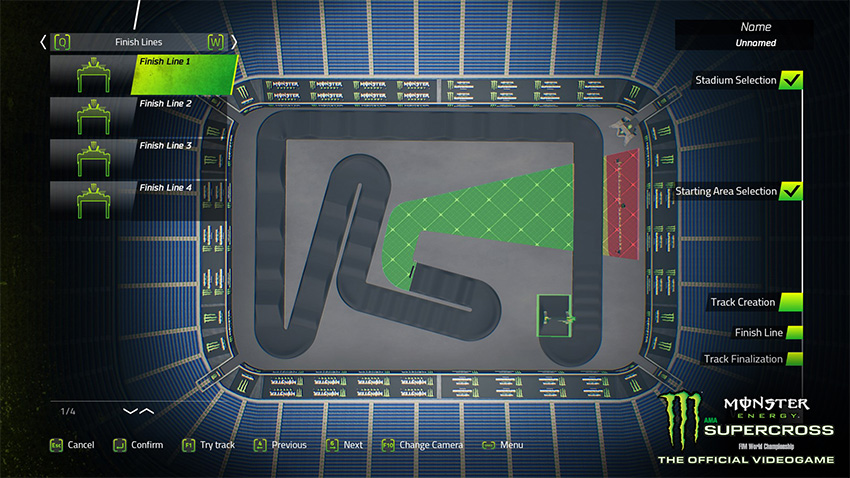
This deep level of personalisation has been extended to the bikes, too. You can now change the bike’s colour, handlebars and grips, add decals, and upgrade components such as the exhaust and brakes to improve performance like before. In a useful feature, multiple rider and bike setups for your rider and bike can also be saved. It’s certainly the most advanced level of customisation to feature in a Milestone bike racer yet, allowing players to create a truly unique bike and rider.
Then there’s the advanced track editor, which is easily the most surprising new feature in Monster Energy Supercross that adds a lot of replayability. Admittedly, track editors were a staple part of older supercross games like Excitebike and Motocross Madness, but they pale in comparison. It’s still a first for a Milestone game, and rare to see in a current-generation racing game.
It’s incredibly intuitive to use, with a clean user interface and a lot of creative control: simply choose a stadium type, set a starting point, and it’s possible to create a fully functional track within minutes. There are few restrictions, giving you the freedom to adjust the angles of corners, whoops and jumps to create the most challenging circuit your devious imagination can dream up.
Completed tracks can then be uploaded online for other players to try, while a user ranking system makes it easy to find the most popular tracks. The potential for a thriving community here is huge, and there are already lots of creative track designs available to download. It’s just a shame there are no spectators populating the stands, as the custom tracks feel empty in contrast to the rousing atmosphere in the official stadiums.
One of MXGP 3’s most innovative features was its dynamic terrain deformation. This added an extra layer of challenge, as the bike’s tyres carved deep ruts and grooves into the ground, significantly altering the racing line every lap. While the terrain still deforms in Monster Energy Supercross, particularly in wet and full-length races, it’s been downgraded since MXGP 3 and has a less profound effect on the bike physics. There is a logical explanation, however, as supercross stadiums feature artificial dirt surfaces that don’t deform as easily in contrast to the natural terrain in MXGP tracks.
On release, Monster Energy Supercross suffered from a few technical issues that took the shine off the game. Every race grinded to a halt on standard PS4 during the initial gate release and the first corner when the pack got congested, but the frame rate is noticeably more stable since the release of the latest patch. That said, there is still some serious slowdown during the first corner in certain tracks. On consoles, the frame rate is locked at 30fps, even on Xbox One X, but PC players benefit from a smoother 60fps experience, making it the preferred platform if your hardware can run it.
Loading times are still ludicrously long, though, which makes the menus a chore to navigate. Be prepared for a long wait when testing a custom track, too. A short five-minute session can take nearly ten minutes in total if you include the time spent waiting for the menus and race to load – on modern hardware, this is unacceptable.
Online multiplayer in Monster Energy Supercross supports up to 12 players. Fortunately, it’s now possible to spectate online races so you’re no longer forced to stare at the lobby screen during the agonising wait for the event to start, but the lack of matchmaking means you’ll rarely race against similarly-skilled players. Races with lower player counts can be populated with AI opponents, but multiplayer matches often suffer from serious lag and freezing issues due to the lack of dedicated servers.
Monster Energy Supercross’s steep learning curve, technical issues, and underwhelming career mode make it difficult to recommend to casual players, but this is undoubtedly the game supercross fans have been waiting for. With its intense, challenging, and technical racing, vastly improved visuals, extensive customisation options, and powerful track editor, Monster Energy Supercross is the best video game representation the sport has ever had, but it has limited appeal for non-enthusiasts.
Our Review
The good
Deep and rewarding riding physics.
Great graphics.
Intuitive track editor adds longevity.
Extensive customisation.
The bad
Limited tutorials don’t provide enough guidance for novice players.
Underwhelming career mode.
Stuttering frame rate when the action gets intense.
No matchmaking in online multiplayer.
Summary
Monster Energy Supercross’s steep learning curve, technical issues, and underwhelming career mode make it difficult to recommend to casual players, but this is undoubtedly the game supercross fans have been waiting for. With its intense, challenging, and technical racing, vastly improved visuals, extensive customisation options, and powerful track editor, Monster Energy Supercross is the best video game representation the sport has ever had, but it has limited appeal for non-enthusiasts.


